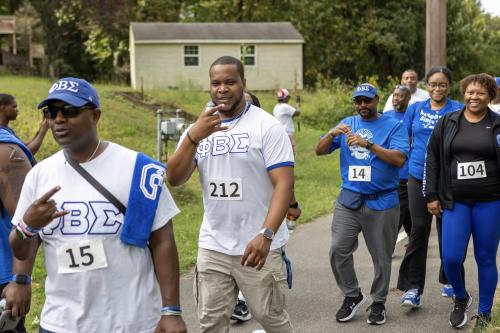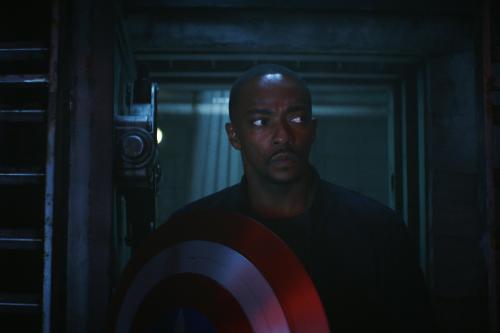Editor’s Note: Kelvin Childs, a development writer in the Division of Development and Alumni Relations, helps share stories that strengthen Howard’s mission and community. In this piece, told in his own words, he reflects on the first chapter not just facing not one, but two different cancers.
This story is part of Howard University’s editorial focus on cancer over the past month.
By Kelvin Childs
The first time my primary care physician saved my life was when he flagged something on my annual physical.
That alone makes me different than many Black men, who fear going to the doctor. Or worse, going to the hospital, seeing it only as a place to go to die. Not me. I get my annual physicals, have a great rapport with my physician, whom I’ve seen for decades. So, when he told me there was an abnormal reading on my PSA test, I took it seriously.
The PSA test (short for prostate-specific antigen) was first devised to determine if there is cancerous activity in the body after the prostate gland is removed. The reading should be zero. If not, there’s a problem. Then someone thought, why don’t we give the PSA test to people who haven’t had the organ removed?
In my case, my physician flagged my PSA test around 2012 because the number wasn’t zero, although he noted that the results were within the normal range.
Being a guy, I did nothing with this information. (I guess I’m not so different than other Black men after all.) The next year, the PSA test number again wasn’t zero, but it fell within the normal range. Being a guy, I still did nothing. Same the following year.
But I had a conversation with my brother-in-law. He pointed out that the issue wasn’t that the number was not-zero or within the normal range but that the numbers kept changing.
Hmmm. With that information, I investigated further. I had an MRI done. And then the bad news: There was a tumor in my prostate.

Prostate cancer is treatable and sometimes curable, if detected early, Childs writes. See details about screening and testing at the bottom of this page. Photos by Skyla Jeremiah, Office of University Communications.
Confronting Reality
I’ve never liked the description “fighting cancer” or “battle with cancer.” It implies that if you die from it or have less-than-optimal outcomes that you failed. Nobody says you lost a battle if you have something sudden like a heart attack or get hit by a bus, for example.
Prostate cancer is an abnormal, rapid growth of cells in the prostate gland, which is part of the reproductive system; it produces semen. It is located just below the bladder and the urethra — the tube that carries urine out of the bladder and out of the body — passes through it.
What I’ve learned about prostate cancer is that it’s regarded as one of the easiest ones to deal with. First of all, half the population, being female, never has to be concerned about getting it. Also, it can lie dormant within your body for years, even decades, without turning malignant. One could possibly live to a ripe old age and die comfortably without it ever being a problem.
Still, the danger is that it can turn malignant at any moment and spread quickly through the body, with no way to predict when. Worse, in Black men, when that happens it doesn’t go from zero to 60; it goes from zero to 1,000.
Prostate cancer is treatable and sometimes curable, if detected early. But Black men tend to have worse outcomes on nearly every score. They are more likely to contract it and more likely to be diagnosed at advanced stages or at older ages. They are also more likely to have aggressive tumors that grow rapidly and metastasize—that is, spread to other parts of the body. Research published in the Journal of Clinical Oncology shows that Black men are disproportionately affected, and sadly, they are more likely to die from the disease.
The reasons for these results in Black men are not fully understood. Some suspected factors are less access to quality medical care and insurance; poor diet and lifestyle, including smoking and alcohol abuse; maladies like diabetes and heart disease; environmental factors like pollution and stress; general mistrust of the medical community; and a shortage of doctors who look like them that they can trust. (My primary care physician is Black man, by the way, and I trust him implicitly.)
There are various approaches to dealing with prostate cancer: surgery, chemotherapy, radiation treatment, hormone therapy, even freezing. There’s also active surveillance or watchful waiting: Because a tumor can remain unchanged for months, years, even forever, the approach was to take a PSA test every quarter and act only if the numbers shift significantly. That sounded good to me.
Indeed, I read an article in The Washington Post (too late to help me) that stated that because prostate cancer acts as it does, many men may have had unnecessary surgeries when watchful waiting might have been the better approach.
As I considered my options, I didn’t have to read every word to know I didn’t want to do chemo or radiation. To my mind, surgery is exact: Find the offending item and slice it out. Bombarding the body with radiation to attack a tiny tumor seemed to me as imprecise as using a fire hose to wash the dishes.
I wasn’t thrilled about losing a body part— I don’t even like getting my hair cut — but in the end, that was my choice. Other people, rightfully, may choose differently. I know of someone who turned down surgery once he understood the side effects, including the possibility of lifelong incontinence. He heard that and said, “Nope! Not for me!” and went with hormone treatment. My urologist performed what’s called “nerve-sparing” surgery, designed to leave my body functions intact. Still, surgery offers no guarantees in life, only odds.
Many Paths, One Struggle
I know of someone else who is elderly and the other risks of surgery, like dying, took that off the table for him. Another person I know is trying herbal-based therapy, which is consistent with his vegan lifestyle and spiritual beliefs. You have to choose what makes sense for you.
One surprise to me was just how many people I know who have this issue, including two cousins, two other relatives, and several other friends from church and other settings. Prostate cancer is truly more common than you know.
At the time I had to deal with this, the option of laser-assisted laparoscopic surgery was coming in vogue. It works by way of a camera and two probes that enter the body through incisions about the size of a nickel. Its benefits over conventional surgery — i.e., slicing open the abdomen to locate the diseased organ — include minimal scarring, shorter recovery time and, supposedly, less pain.
However, in my research I came across an article from a learned surgeon who was down on laser-guided surgery. There’s nothing like opening the body and seeing what’s there with your own eyes rather than the constrained view from a minuscule camera, he argued. Plus, he wrote, many doctors’ practices buy this equipment and may push for surgeries to justify the investment.
I consulted with this surgeon, who told me two things: Laser-guided surgery was perfectly fine for my case if that’s what I wanted done, and watchful waiting was out of the question.
My tumor was located on the wall of my prostate, where it abuts the bladder. The risk of it going from zero to 1,000 and the cancer spreading into the bladder and from there to my urinary system and anywhere else was too great. He told me I had to choose whatever treatment I was going to do — chemo, radiation, hormones, What. Ev. Er. — and do it sooner rather than later. And by “sooner,” he meant within the next three months. By “later,” he meant six months.
So, surgery it was. Unfortunately, by then it was January, and the day we scheduled for it was the day after a massive storm dumped about four feet of snow on every road in the region. It was impossible to get out of my driveway. A neighbor with a truck volunteered to drive us to the hospital, but he couldn’t get even one block away from his house.
I live down the street from a school, which ensures that road always gets plowed. So, for the first time in my life, we called Uber. The driver showed up in an SUV, which is actually for terrible terrain, not everyday traffic, and whisked us away through an eerie white landscape, in some places driving on the wrong side of the highway because the correct side was blocked. But he got us there and we checked into the hotel next door to the hospital as planned, so we could make our appointment the next morning.
The next day came, and we walked over to the hospital, went through the necessary rigamarole with the paperwork and disclosures, and it was time. I went to a waiting area where I changed out of my clothes to a hospital gown, but they asked me to put it on backward and tie it in the front, the better to gain access. Everything I was wearing and the contents of my pockets, I placed in a large clear drawstring bag.
I met with several nurses and doctors on the surgical team who each asked for my name and date of birth, explained what they were about to do, asked me if I understood, and asked me to sign documents to that effect. I was wheeled into the surgical area, transferred from the gurney I rode in on to the surgical gurney, and moments later, the anesthesiologist put me under.
Recovery
I woke up in the recovery room with the greatest pain I’ve ever felt in my entire life. Supposedly this was less than if I had had full abdominal surgery, but I didn’t have a basis for comparison. I just knew it HURT!!!
I am told that I had a conversation with my wife and my urologist, but I have absolutely no memory of it. None. To me, it’s like it never happened.
I spent a few days in the hospital. My urologist needed assurance that I could get up and walk around, that I could urinate and, most of all, that it was just urine coming out of me and not any blood. To that end, a catheter was placed into the tip of my penis, connected to a bag to capture the fluid. I lived with that for a couple of weeks, even after I got home.
The results were positive; no blood. On a follow-up visit at my urologist’s office, I got the all-clear to go without the bag, so an assistant yanked the catheter out. OH, MAN, DID THAT HURT!!! Almost worse than the surgery!
I also had a PSA test, and the result was not within the normal range; it was zero, like it’s supposed to be.
I had follow-up PSAs once a quarter for the next couple of years, also getting a zero reading, and the frequency dropped to twice a year, and then annually. Each time, the result was zero. Also, the nerve-sparing surgery worked as desired.
It’s been nine years, and the rule of thumb is that if you’ve gone five years without a recurrence of your cancer, you’re considered cured. My urologist’s office, however, has never used that term; the most they will say is that my prostate cancer is “undetectable.”
To Be Continued
So it is. I am grateful to be here to tell this story, and more so for the love, support and prayers of family, friends and neighbors throughout this experience.
Unfortunately, my physician had to save my life a second time, but that’s another story. Stay tuned.
Know the Symptoms, Get Screened, Save Lives
Prostate cancer often presents no early symptoms, making proactive screening essential. According to Prostate Health Education Network, men should be aware of potential warning signs, including:
- Difficulty urinating or a weak, interrupted flow
- Frequent urination, particularly at night
- Pain or burning during urination
- Blood in the urine or semen
- Persistent pain in the pelvis, hips, or lower back
PHEN stresses that any of these symptoms, especially for men over the recommended screening age, warrant immediate medical consultation.
Because symptoms may not appear until the disease is advanced, PHEN champions early detection through regular screening. This is particularly critical for Black men, who face significantly higher incidence and mortality rates. The goal is to identify cancer at its most treatable stage, often before any symptoms arise.
The primary screening tool is the Prostate-Specific Antigen (PSA) blood test. While some protocols also use a digital rectal exam (DRE), PHEN notes that many community programs focus on the PSA test to encourage broader participation. For diagnosed men, PHEN provides resources on advanced testing, treatment options, and clinical trials.
Beyond testing, PHEN encourages men to take an active role in their health by staying informed, attending community screening events, and partnering with trusted local organizations. If a test is abnormal, prompt follow-up is crucial. For survivors, PHEN offers long-term support through its Survivor Network, monthly meetings, and educational materials to manage treatment side effects.
Related Story

Keep Reading
-

-
 In Your Words
In Your WordsSinners Have Souls Too: The Humanization of the Deep South in Ryan Coogler's Southern Gothic Horror "Sinners"
May 15, 2025 5 minutes -
 News
NewsDoes “Captain America: Brave New World” Take Us On a Ride We Never Asked For?
Mar 10, 2025 6 minutes
Find More Stories Like This
Are You a Member of the Media?
Our public relations team can connect you with faculty experts and answer questions about Howard University news and events.
Submit a Media Inquiry

